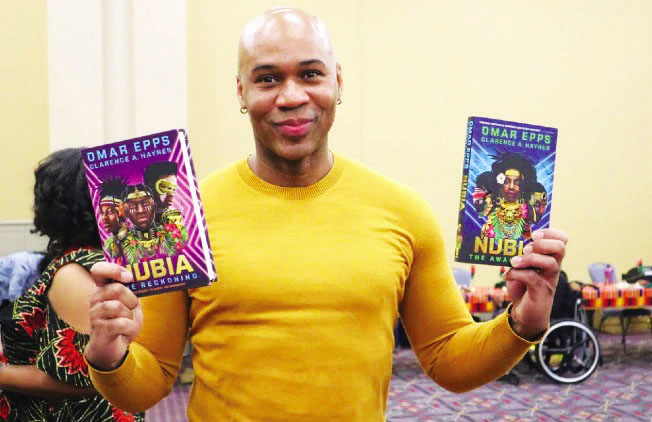By Clarence A . Haynes
When I began writing an urban fantasy glam horror novel — which follows Gwendolyn, a beautiful Black Harlem publicist with a hidden mystical past, and Fonsi, a gay Afro-Latine psychic with dire tidings about vengeful ghosts — I knew I had my work cut out for me in terms of the world-building. I wanted to construct a narrative that would pay homage to my Panamanian-American roots and reference real world spiritual traditions while also having its own unique rules. As is my way when I write, I used music to further immerse myself in the story, using sound to help determine setting or mood or the sensibilities of my cast. For a book that focused on Black and brown urbanites with Caribbean and Latine connections, my playlist artists included Sade, Beyoncé, Rubén Blades, Kaytranada, La India, Luther Vandross, H.E.R., Gloria Estefan, Bad Bunny and more, some of whom are directly referenced on the page.
It took many days of research and conversations with my ever patient editor Krishan Trotman to work through issues, but by the summer of 2024, I had almost everything solved.
Or so I thought. I was taken aback when my editor completed her review of my latest draft and declared, “Your characters are flat.” The story arc and world-building, fine, but the two protagonists lacked complex backstories and motivations. Instead, they were two-dimensional figures merely serving plot, spelling disaster for a novel that’s ostensibly about people coming to grips with literal and metaphorical ghosts from their pasts.
Krishan suggested that I journal, that I scrutinize my romantic experiences to help inform Fonsi’s dating fumbles. And I knew based on her feedback that I had to pay attention to Gwendolyn, too, to really draw out her unfulfilled yearning. I returned to music, thinking about which artists would best represent the core emotional conflict of my protagonists. Gwendolyn and Fonsi each long for a type of vulnerability usually cultivated with that special someone, but they’re unable to grasp what they really desire because of unresolved trauma. Gwendolyn has stoically walled herself off from true romance while Fonsi has anxiously stumbled from one erotic situation to the next, even having (forbidden) carnal relations with a spirit.
I realized I needed sounds that were lush, that could carry these characters’ emotional weight. I adore ’70s classic soul, as represented by artists ranging from Stevie Wonder to Chaka Khan and Rufus, but songs from this era wouldn’t quite mesh with my characters. I needed music that was more contemporary, slicker, especially considering Gwendolyn’s cool temperament.
And so I turned to Babyface, the singer/songwriter, musician, and producer who crafted synth-driven pop and R&B hits throughout the ’80s and ’90s, performing his own work as seen with “It’s No Crime” or “When Can I See You,” or providing tunes to others like “Exhale (Shoop Shoop),” “Not Gon’ Cry” and “Take a Bow.” (He’s renowned for being a male producer who understands how to write and produce for women.) And I turned to chanteuse Toni Braxton, Babyface’s frequent collaborator with super popular singles like “Another Sad Love Song,” “Breathe Again,” and “You’re Making Me High.” To hear Braxton embody a Babyface track is to witness someone with phenomenal technique sing without worrying about irony or stylistic subversion. These songs were birthed before social media algorithms shaped the direction of popular music, when singles and their accompanying videos had less winks, less meta commentary, less need to be provocative. And these songs would’ve informed my characters’ formative years.
I listened to Braxton and Babyface albums nonstop for weeks. Braxton’s 1996 blockbuster album Secrets became the cornerstone of my process, Babyface having writer or producer credits on most of the tracks. I listened to Braxton croon about how she needs to get a man, a somewhat cringeworthy sentiment in what’s supposed to be our independent, liberated era. Yet it’s also an honest, unequivocal call for intimacy and closeness with no shame. Braxton shares an aching need to be vulnerable only to realize by album’s end that such unions can result in horrible betrayal, her words of lament surrounded by swelling, lush orchestration.
Amid this soundscape, I journaled. And as I thought about my own experiences that connected to Secrets and those of my characters, I cried. I further revised my characters and their histories, and more tears came. I revised some more and cried some more, letting the dormant emotions that resided within permeate my body. I sat with that type of discomfort for weeks and let the process breathe life into Fonsi and Gwendolyn as they began to tell me who they were. I soon felt something akin to relief as the process became cathartic, as I discovered an odd kind of happiness over being human and inhabiting these emotional spaces.
This past spring, I went to a club party thrown by Black Market in Brooklyn. Legendary drag musician/performing artist Kevin Aviance was DJing. In a twist, he ended his up-tempo house music set with an easygoing slow jam — “Can We Talk” by Tevin Campbell, a sprightly ode to flirting written and produced by Babyface as well as Daryl Simmons. Most of the crowd sang along at the top of our lungs even though many clubgoers would’ve been wee babes when the ballad came out. It was a moment of collective joy where we could be free and exult in being earnest, what I always wanted for Gwendolyn and Fonsi.
Clarence A. Haynes, a native Afro-Latinx New Yorker, is the coauthor of actor/producer Omar Epps’s lauded sci-fi/fantasy series Nubia: The Awakening and The Reckoning. He is also the author of the middle-grade nonfiction work The Legacy of Jim Crow. Haynes has penned articles for Newsday, Huffington Post, The Root, and The Grio, among other publications. He resides in Brooklyn, New York.
Source: LITERARY HUB (https:// lithub.com), July 2, 2025.
